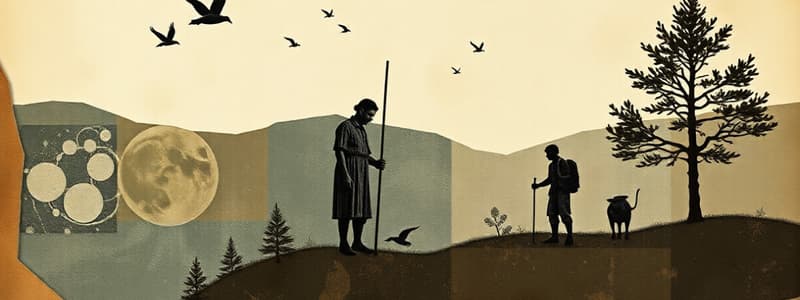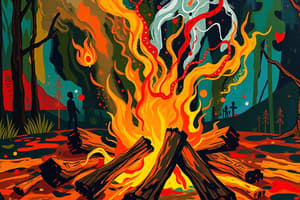Podcast
Questions and Answers
What material was used to boil water according to the passage?
What material was used to boil water according to the passage?
- Metal pot
- Clay pot
- Skunk cabbage leaf (correct)
- Plastic container
What natural resource did the character realize was essential for their survival and comfort?
What natural resource did the character realize was essential for their survival and comfort?
- Edible plants
- Water (correct)
- Firewood
- Shelter
What did the character use to start a fire inside the tree?
What did the character use to start a fire inside the tree?
- Matches
- Burning stick (correct)
- Lighter
- Magnifying glass
Where was the water source eventually found?
Where was the water source eventually found?
What animals did the character find in the water?
What animals did the character find in the water?
What inspired the character to look for water near the hemlock tree?
What inspired the character to look for water near the hemlock tree?
What method did Native Americans historically use to create dugout canoes?
What method did Native Americans historically use to create dugout canoes?
What was the character's reaction to successfully planning and finding food?
What was the character's reaction to successfully planning and finding food?
Flashcards
Fire for Dugout Canoes
Fire for Dugout Canoes
Using fire to hollow out canoes, a faster method.
Hemlocks and Water
Hemlocks and Water
Hemlocks often indicate nearby water sources such as streams or springs.
Spring (water source)
Spring (water source)
A small, natural water source, often hidden.
Insects with Oars
Insects with Oars
Signup and view all the flashcards
Beetle's Water Movement
Beetle's Water Movement
Signup and view all the flashcards
Crayfish
Crayfish
Signup and view all the flashcards
Delight (surprise)
Delight (surprise)
Signup and view all the flashcards
Boiling water in a leaf
Boiling water in a leaf
Signup and view all the flashcards
Study Notes
- Skunk cabbage leaf was used as a cup to boil water with grass strands
- Boiling water in a leaf works because the water keeps the leaf wet, preventing it from burning completely
- The top of the leaf dries up and burns down to the water level, but no further
Using Fire to Make a Dugout Canoe
- American Indians used fire to make dugout canoes
- Burning the wood out was an easier and faster way to get results
Discovering a Spring
- Discovered that a water source was needed nearby for cooking, drinking, and comfort
- Recalled the fact that "Hemlocks usually grow around mountain streams and springs."
- Found a spring guarded by two boulders, decorated with flowers, ferns, moss, and weeds
- The spring water was clear, with insects rowing in it and beetles moving on the surface
- Crayfish were found in the spring
Catching Crayfish for Food
- Initially hesitated to catch crayfish due to their pinching ability
- Overcame the hesitation by thinking about hunger
- Successfully caught crayfish and wrapped them in leaves to carry back
Problem Solving and Planning
- Realized the lack of a bucket to carry water to the tree
- Remembered how accustomed to city conveniences like taps and buckets he was
- As a substitute, decided to use dirt to smother the fire
Time Progression
- Spent days working, burning, cutting, and gathering food
- Marked each day on an aspen pole calendar stuck in the ground
Studying That Suits You
Use AI to generate personalized quizzes and flashcards to suit your learning preferences.




